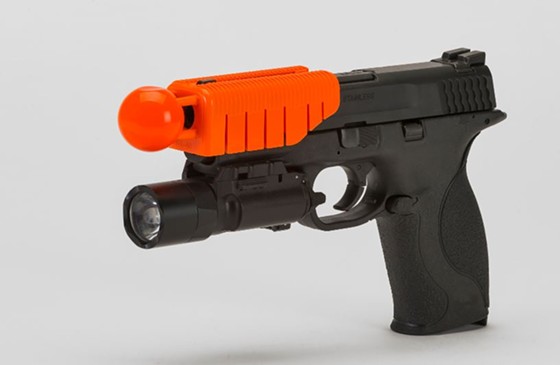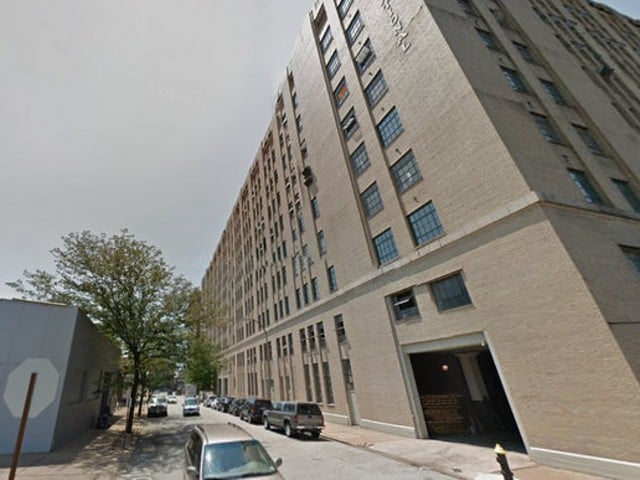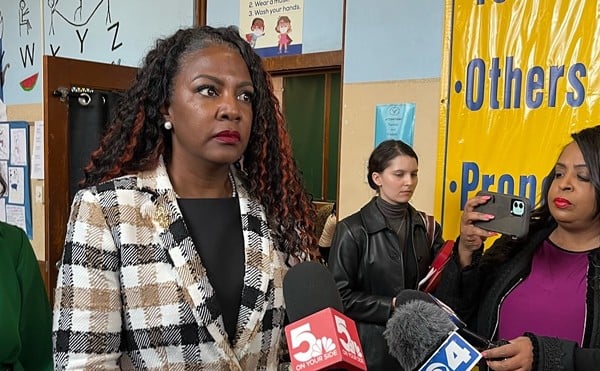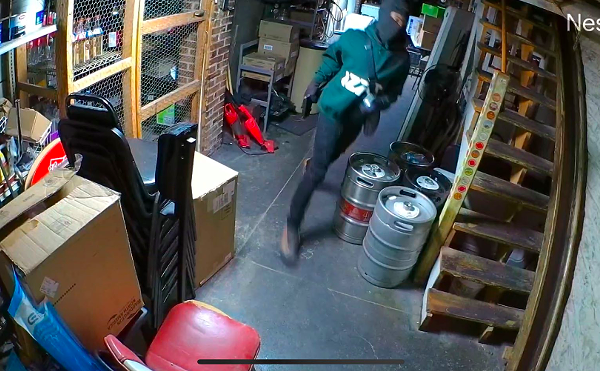
With its bright orange frame, the "Alternative" almost makes a pistol look like a toy. But the invention, which has never been field-tested, could offer police departments just the tool they've been looking for, the kind of weapon that exists in the gray area between lethal and non-lethal force.
"It's not a beanbag and it's not a taser," says Christian Ellis, chief executive of California--based Alternative Ballistics, which produces the pistol attachment. "I love those products and they have great applications, but they're designed for less than lethal situations. This is designed for a lethal situation."
This week, a few select Ferguson officers began training with the weapon some have dubbed the "Bozo Round" after the orange ping-pong-ball sized projectile that (sort of) resembles clown's nose. Placed over the muzzle of the handgun, the apparatus is designed to capture a just fired bullet and use its energy to send the metal-alloy sphere rocketing toward a target at 250 feet per second.
See also: St. Louis Police Chief Spars with Aldermen Over Use of Deadly Force
There is one significant catch. The Alternative is a one-shot system, and after the Bozo Round flies off the entire frame system is ejected. That means the officer's next shot, which can be taken immediately, will be the real deal.
Here's a news spot that shows the entire process in action.
According to Ellis, the weapon is meant to be used in "non reactive" situations, such as confronting a suspect who, although armed, is not immediately threatening the officer or civilians.
"This is when the officer has the time to put this on the weapon, knock the person down and put them in immense pain," he says. "They're probably going to end up with some broken ribs, maybe a fractured sternum, but the odds of them living has increased dramatically."
However, Ellis acknowledges that the Alternative doesn't seem to fit the established police distinctions between lethal and non-lethal weapons. Shooting a bullet-powered metal sphere at a human body can cause serious injury, and Ellis says that a "very small percentage" of those hit by the projectile could die.
"I'm not saying it's a non-lethal weapon. I'm telling you it's a lethal force option," he says.
Calling the Alternative a "lethal force option" isn't just wonky marketing semantics -- the weapon is intended to be used when, by law, a police officer would be justified in firing real bullets.
So what kind of scenarios would the Alternative come into play? Ellis suggests cases of mentally ill individuals carrying knives or threatening suicide, situations where officers would prefer to deescalate rather than take a life.
Ellis' example brings to mind the August 19 death of Kajieme Powell, a 25-year-old, possibly mentally disturbed man who was shot and killed by two St. Louis metro cops after he approached the officers holding a knife. Powell's death furthered the public discontent sparked by the officer-involved shooting death of Michael Brown two weeks before. During a public safety hearing in September, some aldermen questioned St. Louis Metropolitan Police Chief Sam Dotson on why his officers didn't shoot Powell in the leg or use a non-lethal weapon, like a taser.
Dotson answered that tasers frequently misfire and are not always effective in bringing down armed suspects, and that a failed non-lethal attempt can put officers' lives at risks. He cited the department's use of force guidelines, which legally justifies deadly force when a knife-wielding suspect comes within 21 feet of an officer.
"We don't do warning shots. It's not like the movies when you do trick shots, shoot for the knees or you shoot for the hands," Dotson said at the time. "If deadly force is authorized, then deadly forced is authorized."
Ellis would argue that the Alternative provides a desperately needed middle ground for officers, and he describes the technology as straddling the space between tasers and outright deadly force. Ideally, he says Alternative would supply an officer with the means to end dangerous encounters by inflicting grievous injury instead of death. On the other hand, the Alternative is designed to return deadly force on the very next shot if the suspect refuses to yield.
Unsurprisingly, the new weapon has drawn mixed reactions from law enforcement across the country, and Ferguson Chief Thomas Jackson says his department has not drawn up any policies for the weapon. He adds that the city council has not endorsed it and that officials "have made no commitments" to the Alternative, reports the St. Louis Post-Dispatch.
"We agreed to take a look at it without committing to use it or deploy it," says Jackson. "It's not a done deal; we're just looking at it like we would anything else, and it doesn't cost us anything to look."
If you're curious what it would look like to be hit by the Alternative, you're out of luck. Ferguson is the first domestic police department to try out the weapon, and Ellis says it would be dangerous and unethical to test the projectiles on anything but ballistics gelatin:
Follow Danny Wicentowski on Twitter at @D_Towski. E-mail the author at [email protected]





